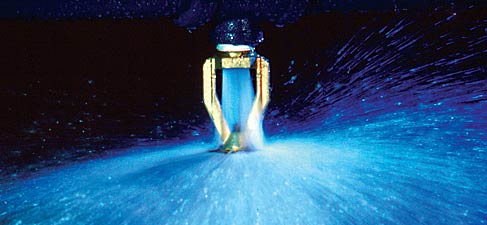Why are we required, or need to have a fire sprinkler systems installed?
Lets face it, when speaking of fire sprinkler systems being installed in new construction there is little choice to be had when following code requirements. As with all code, the intention and direction of any requirement is safeguarding the occupants of the structure and not the structure itself. Fire sprinkler systems are one of the key elements in the myriad of requirements for new and renovated spaces and structures providing for the life safety of the people that inhabit or occupy those spaces or structures.
Generally speaking fire sprinkler systems are always required in any enclosed area or structure that is capable of holding a large number of people, (assembly type occupancy), or enclosed areas or structures that people with a need for assistance in escaping from a fire situation are housed. This is especially true where sleeping accommodations are a major function of the space or structure. (Institutional, Educational, Transient Lodging (Hotel-Motels), type occupancies are prime examples of this type of space). Finally any space or structure that has a high level of hazardous materials stored, or hazardous conditions where people work, would be another example of where the code leaves no choice in providing a fire sprinkler system.
That brings us to spaces that are not required to have fire sprinkler systems. In most small businesses and individual residences fire sprinkler systems are not required by code. There are some exceptions to this and a number of individual State and Municipal Codes are recognizing the benefits of Life and property safeguarding and are beginning to require these spaces to have fire sprinkler systems installed.
It is well documented that the percentage of fatalities of those involved in a fire situation decreases dramatically when fire sprinkler systems have been installed and are operating properly the way they were designed.
by: Jonathan Bell – Project Manager, Peters & Associates, Architects, P.C.
Here are a few of the Myths that tend to foster bad feelings and resistance to installing a fire sprinkler system whether required by code or not. (This particular list was found on a web page issued by Tufts University, Fire Safety Department Medford Ma.)
MYTH 1 “Water from Sprinkler systems will do more damage to the structure than the fire it’s putting out.”
Fact: Quick response sprinkler heads flow rate is about 8-24 gallons a min compared to firefighting equipment hoses that have a flow rate of about 80 to 125 gallons a minute, plus damage from fire and smoke will be far more extensive if fire is allowed to spread and it will spread quite quickly.
MYTH 2. “When a fire starts and a sprinkler system is activated every sprinkler head starts to put out water.”
Fact: Sprinkler heads are individually activated by fire temperatures in excess of 155°. Residential fires are usually controlled with one sprinkler head. 90% of all fires are controlled with six or fewer heads and a study conducted during 80 years of automatic sprinkler use found that 82% of the fires that have occurred were controlled by two or fewer sprinkler heads.
MYTH 3. “A smoke detector provides enough protection.”
Fact: Smoke detectors save lives by providing an early warning to a smoke or fire incident, but can do nothing to extinguish a growing fire or protect those physically unable to escape on their own, such as the elderly or small children. Too often, battery operated smoke detectors fail to function because the batteries are dead or have been removed. As the percent of homes in America that were “protected” with smoke detectors increased from zero to more than 70%, the number of fire deaths in homes did not significantly decrease.
MYTH 4. “Sprinklers are designed to protect property, but are not effective for life safety.”
Fact: Sprinklers provide a high level of life safety. Statistics reveal that there has never been any multiple loss of life in a fully sprinklered building. Property losses are 85% less in residences with fire sprinklers compared to those without sprinklers. The combination of automatic sprinklers and early warning systems in all buildings could reduce overall injuries, loss of life and property damage by at least 50%.


Leave a Reply